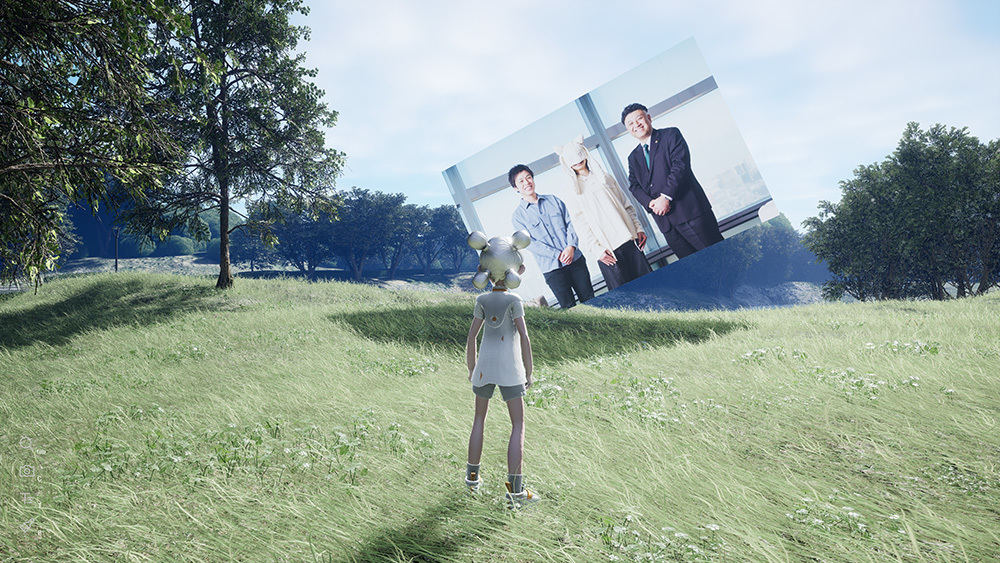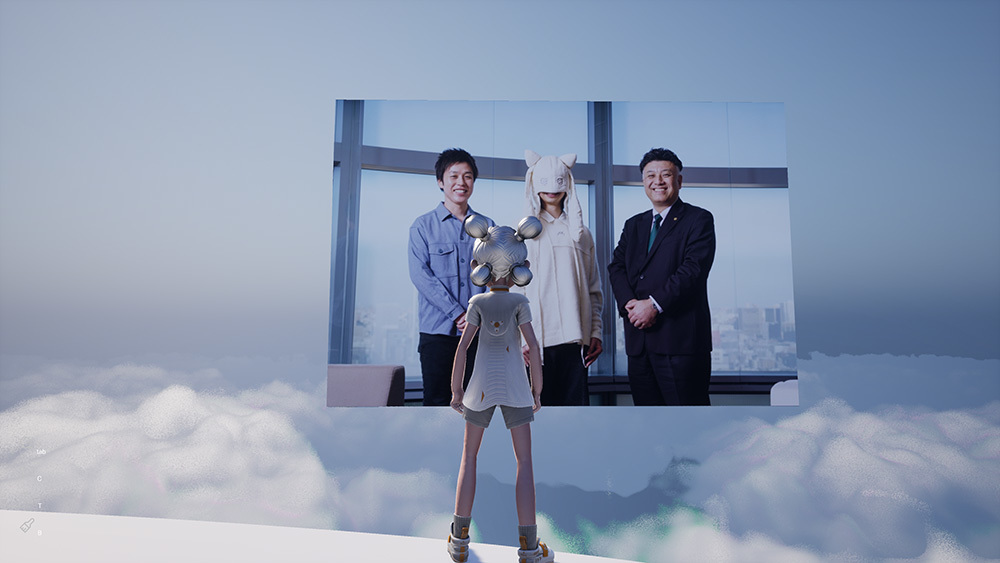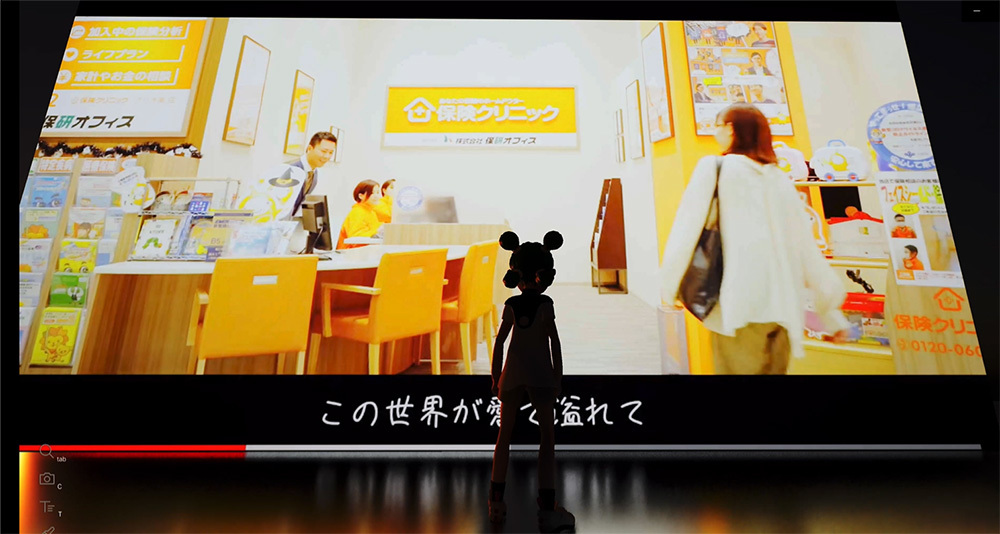This series explores the appeal and potential of SMEs and ventures as content creators. This installment introduces a case where an SME leveraged cutting-edge digital space technology to revitalize its business.
Hoken Office, an insurance agency in Sakai City, Osaka, collaborated with O (Oh), an art technology studio with world-class expertise based in the US and Japan, to create a corporate PR video gallery utilizing digital space. Immediately after its release, it generated significant buzz both internally and externally, drawing attention as a case study pioneering new possibilities for digital adoption within the insurance industry.
What was the underlying objective of this project? How does content creation using digital spatial technology contribute to local communities and SMEs?
Dentsu Inc. planner Kohei Morimoto, who supports O (Oh), interviewed Masaki Tano, Representative Director of Hoken Kenkyujo Office, and a Haru, Founder and Representative Director/CEO of O (Oh).
Creating a society where anyone can engage in "Deep Work" starting from digital space
Morimoto: Thank you for joining us today. First, could you, a Haru, briefly explain O's mission and business activities?
aHaru: Yes. O is an art technology studio aiming to expand human creativity. In the coming AI era, what humans need is "creative thinking power" to solve complex problems. Until now, people have expanded their creativity within physical spaces. For example, taking a walk down an unfamiliar path, venturing out into nature, or visiting an atelier surrounded by objects.
However, today, creative making—both physical objects and experiences—can also be realized in digital spaces. Furthermore, we believe that "experiences uniquely possible in digital spaces" can significantly reduce the cost of creativity, enabling anyone to generate new ideas more easily. Through providing experiences and solutions rooted in digital space creation, and offering the metaverse platform "MEs" for creators to spark idea generation, we are challenging ourselves to build an exciting society where anyone can engage in "Deep Work."
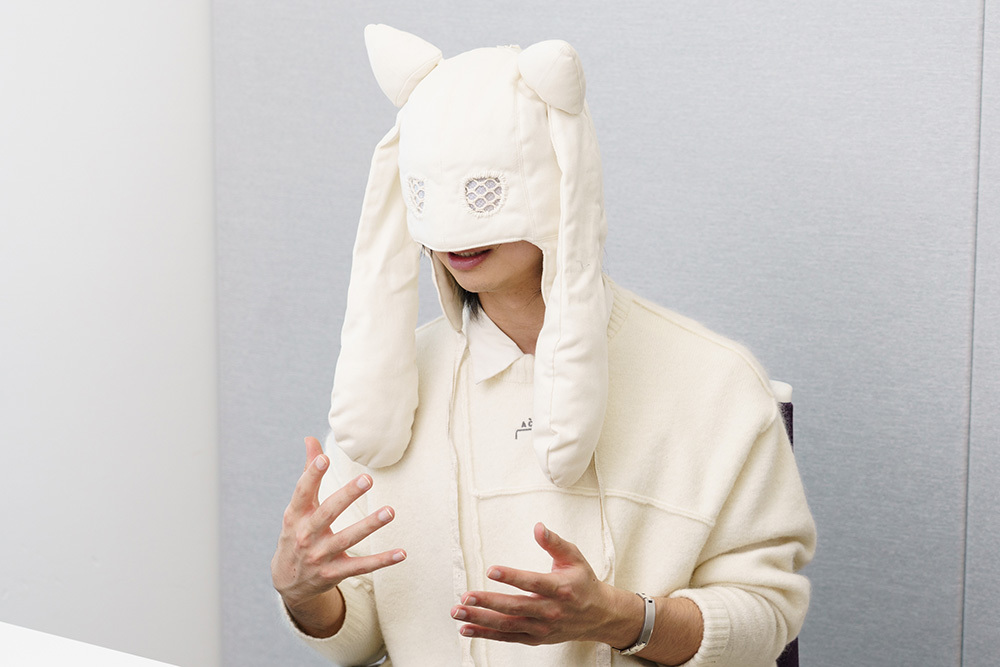
O (Oh) a Haru
Morimoto: So, you aim not only to provide digital spaces as content but also to expand creativity starting from them. Among the many companies providing digital space technology, what is O's strength?
aHaru: First, the breadth of usable technologies. We can create original digital spaces using various tools, including Unreal Engine 5, known for its high-resolution graphics, our proprietary engine, Unity, Blender, Houdini, and more. This allows us to build fully customized worlds or utilize templates for low-cost, speedy production.
Another strength is our deep understanding of art and design. I myself studied industrial design at the Rhode Island School of Design (RISD) in the US and continue to work as an artist. Our team also includes former RISD professors and 3DCG artists from major game development companies, enabling us to provide direction from a team well-versed in the art and design fields.
Morimoto: One key factor in deciding to collaborate was our own admiration for the high quality of the digital spaces O creates. The avatars move naturally, and data can be placed as objects within the 3D space. It's possible to hold daily meetings or brainstorm project ideas within these meticulously crafted, exciting spaces. Furthermore, we can create immersive experiences that let people who cannot freely travel or go out experience the appeal of local areas and the world through digital spaces. We can also develop projects that allow people overseas to feel Japanese culture with a sense of immersion. Additionally, we can create solutions that visualize the appeal of companies—which can be difficult to convey through words alone—within digital spaces.
In this way, we see significant potential not only in creating outstanding content but also in developing solutions that can revitalize regions and small-to-medium enterprises across various fields. We aim to challenge ourselves in developing new projects that contribute to solving social issues by collaborating with the knowledge and assets held by regional media and support organizations.
Dentsu Inc.'s specific support includes helping to clearly visualize the intrinsic value of O, planning to implement the vision, sales support, and project management assistance.

Case Study ①: Reapproaching Town Development and Shopping Districts (Both Physical and Virtual)
Client: Kengo Kuma & Associates, Toho Leo, Any
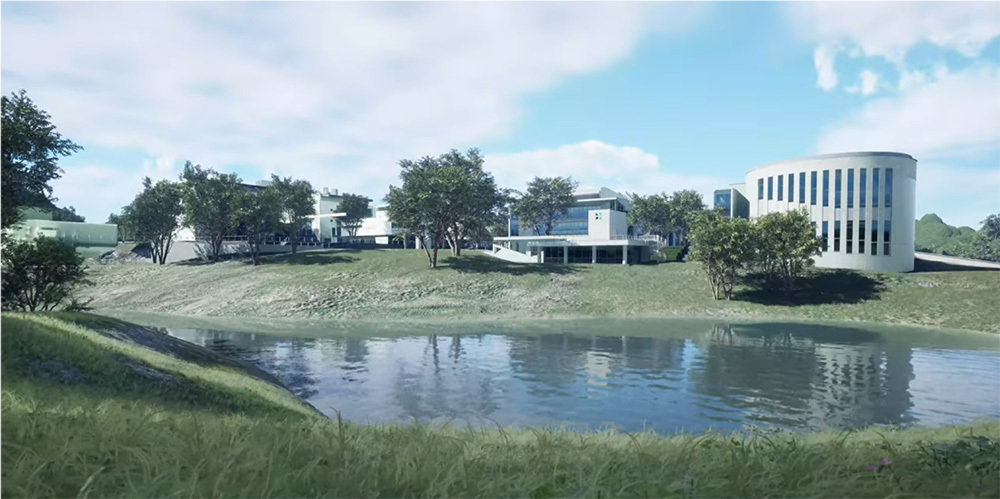
Case Study 2: Digital Twin Campus Joint Research (Practical Application of Identifying and Solving Issues Through Physical-Virtual Synergy in Educational Settings)
Collaborators: Keio University SFC Research Institute Digital Twin Campus Consortium, SoftBank
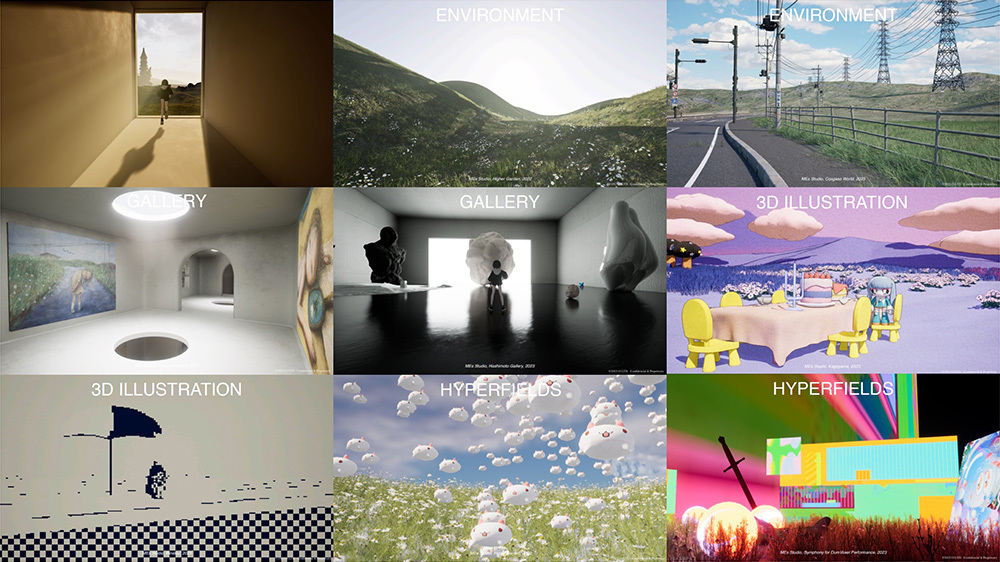
Case Study 3: Original Template Worlds
O has already developed multiple template worlds, enabling cost-effective world development tailored to various uses and purposes. Of course, world development from scratch is also possible.
Fusing the cutting-edge nature of digital space with the unique "warmth" of Hoken Office
Morimoto: When considering regional and SME revitalization using O's technology, the first company I absolutely wanted to approach was Hoken Office, which has repeatedly entered the NIKKEI Company Song Contest. Mr. Tano, what were your initial impressions when you first heard about the project?
Tano: When you first explained O's business and Ms. Aharu's background, it felt like hearing about a completely different world (laughs). At the same time, I remember feeling excited about the possibility of utilizing digital space—a world previously distant to us—because you proposed a plan we could actually implement.
Our company had been advancing digital utilization for some time, but insurance products inherently require a strong trust relationship between customers, the company, and sales staff. We must consider how to build that trust in the online society moving forward. In this context, I felt this initiative could be a catalyst for exploring a digital approach that fits our company's identity.
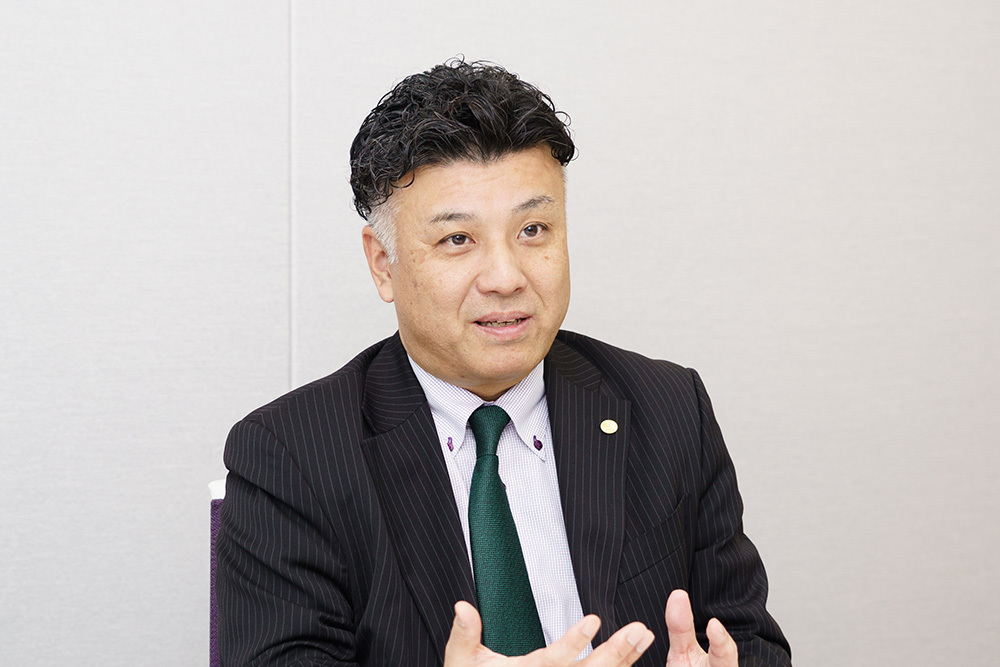
Mr. Tano, Hoken Research Office
Morimoto: Personally, I was deeply drawn to the thoughtfulness and warmth of Hoken Office's employees. I believed this company culture would align perfectly with the atmosphere O (Oh) creates in its digital space. That's why I proposed a project where people could experience Hoken Office's "warmth," condensed into their company song video, within this digital space.
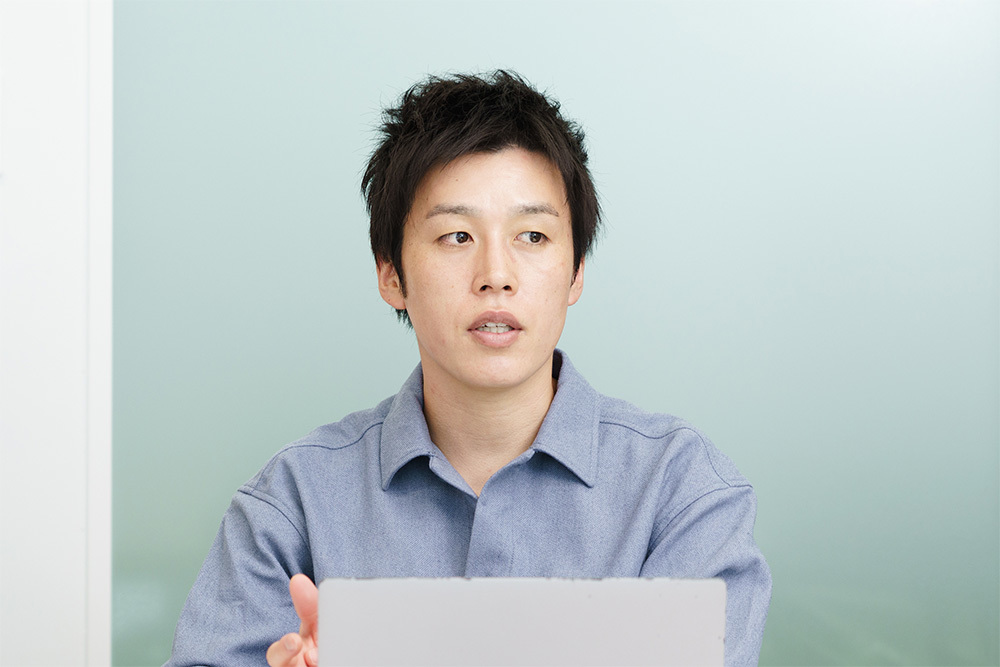
Dentsu Inc., Mr. Morimoto
Tano: At our company, we've produced multiple corporate song videos with the intention of conveying our cherished motto through song and video to our customers and employees. Thanks to this, we've seen positive impacts both internally and externally. However, we also recognized that getting people to watch all the videos in their entirety was quite challenging. That's precisely why we thought offering a digest-style experience of the corporate song video within the digital space could help deliver our message to a wider audience.
Furthermore, conveying the appeal of insurance work to young people is a challenge not just for our company, but for the entire industry. This time, we also wanted to create an opportunity for young people to become interested in the insurance industry by having an insurance agency like ours take on the challenge of the digital space.
Morimoto: Precisely, we thought using digital space would make it easier to convey the appeal of Hoken Office to younger audiences—that was one reason we reached out. Haru, what inspiration did you draw from Hoken Office's company anthem video, and how did you approach creating the digital space?
aHaru: When I first saw the Hoken Office website and videos, the keyword that immediately came to mind was "warmth." I proceeded with the production while thinking about how to let people experience this wonderful culture through expression beyond words.
For example, this time we positioned the camera behind the character, adopting a direction that allows viewers to vicariously experience the character moving around within the digital space. We also incorporated detailed movements where you can almost feel the character's breath, and deliberately included angles where the character stands above the video looking down. These are techniques designed to enhance immersion and keep the content engaging.
Tano: It's a unique presentation, isn't it? While showcasing the cutting-edge nature possible in digital space, it also firmly captures the warmth and important message inherent in the original video itself. I think it's content that truly conveys the essence of Hoken Office.
Morimoto: The timing of the sunset filtering into the background and the music transitions are also superb, really highlighting the key scenes from each company song video. Even though I was involved, I was genuinely moved when I first saw the finished videos. How did people inside and outside the company react?
Tano: Since I pretty much pushed this project forward on my own initiative, everyone was surprised when the content suddenly appeared on the website (laughs).
Morimoto: You created that banner on the homepage saying "Metaverse Space Entrance," right?
Tano: Exactly. The reaction was, "What is a metaverse space?" (laughs). But once people actually saw the content, they were really pleased. They saw it as an opportunity to use this new digital space as a hook to convey our values and how we work to more customers.
aHaru: That's great! Just challenging ourselves with new initiatives like this helps create an image of the company being open-minded. As someone who isn't particularly knowledgeable about insurance myself, seeing this content made me think my image of the insurance industry might change.
Tano: That's a crucial point. While insurance fundamentally delivers peace of mind to customers, it's also true that some people harbor distrust or anxiety, wondering, "Will they try to sell me unnecessary things?" or "Will they pressure me to buy?" To dispel that negative image, the entire industry—not just us—needs to build trust with customers. This project feels like a highly meaningful first step in breaking down that initial mental barrier.
Digital spaces can contribute not only to business but also to social contribution activities
Morimoto: Based on this initiative, how do you view the potential for utilizing digital spaces within the insurance industry?
Tano: Just a few months ago, the digital space felt completely unrelated to our company. This opportunity has given us a fresh perspective on the future of digital adoption and provided us with additional channels to communicate aspects of our company culture that words alone couldn't fully convey. Similarly, the importance of insurance is something that's hard to grasp solely through words, so we also want to explore creating digital spaces that offer a simulated experience.
Furthermore, since our founding, we have dedicated ourselves to providing full support in paying insurance claims when something happens to our customers. However, we believe what matters most is helping our customers live accident-free, healthy, and peaceful daily lives. Guided by the principle that physical and mental health is essential for reducing accidents and illnesses, we have long provided opportunities to improve relationships within customers' households and workplaces. We see potential for digital spaces to contribute to such social initiatives as well.
aHaru: That's wonderful. I also want to go beyond simply creating digital content. I aim to engage in activities that envision creating spaces where people can share moving experiences, sparking curiosity and vitality through their use. I want to deliver a digital world where people gather beyond regional and national boundaries, encountering new inspiration and value.
Morimoto: By combining O's cutting-edge technology with the unique appeal of local businesses, we want to create content that energizes society. Thank you very much for today!
